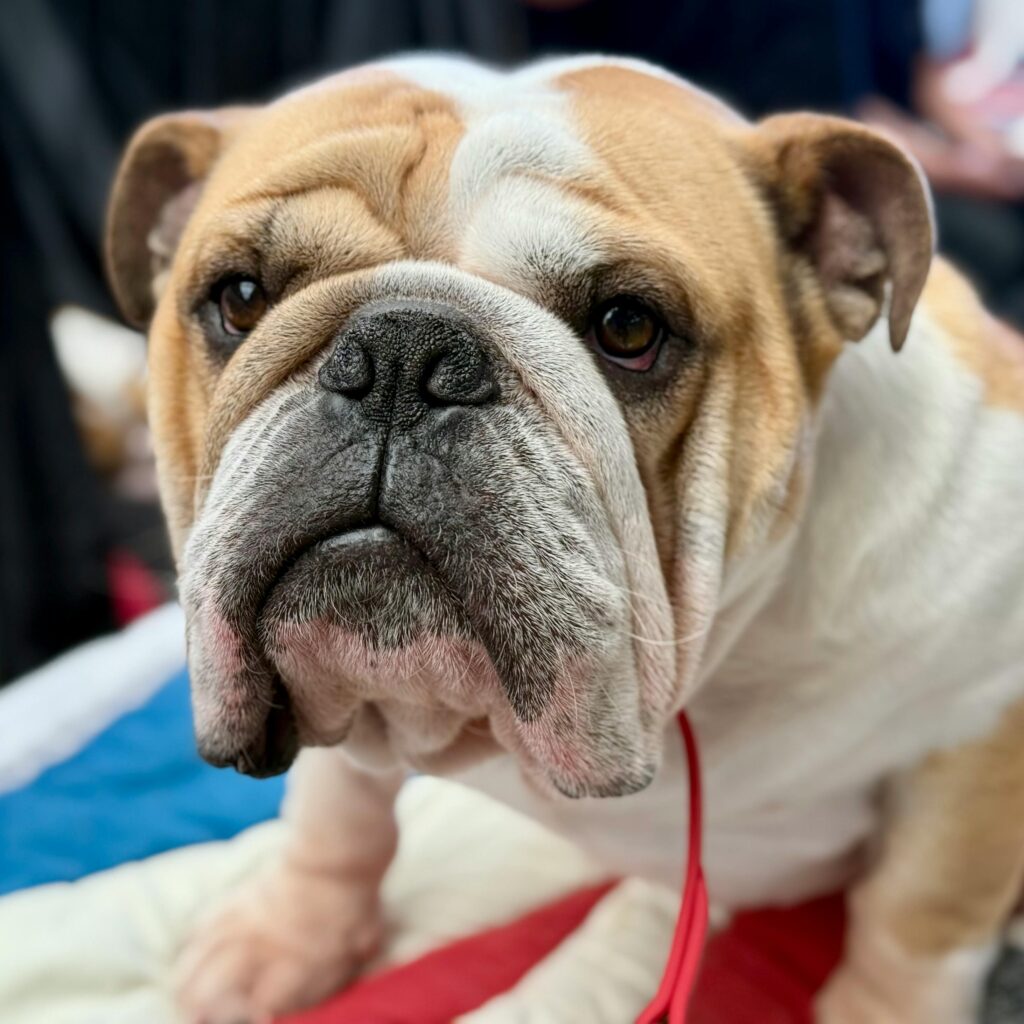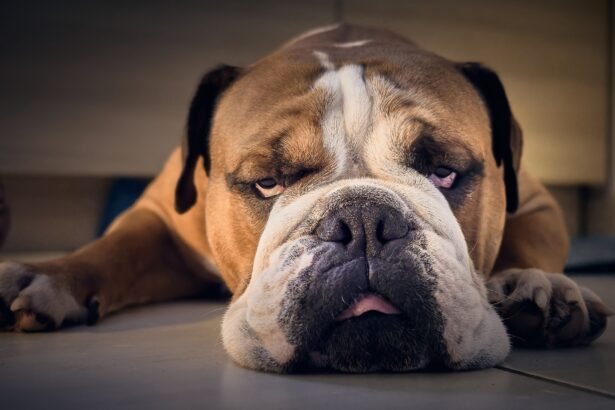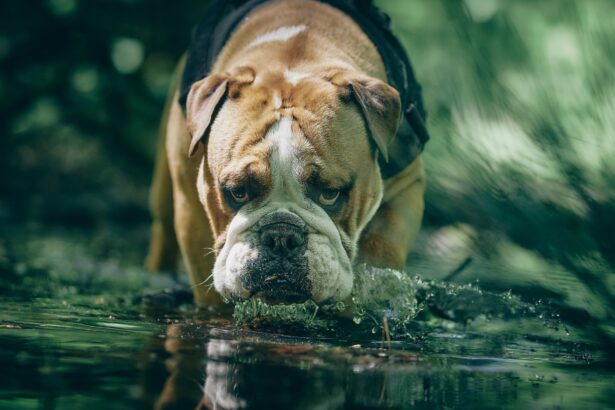British bulldogs are lovable, loyal companions, but their unique physiology means that bulldogs and heat don’t always make for a great combination. As a brachycephalic (short-nosed) breed, they can struggle to regulate their body temperature, putting them at risk of overheating, especially during warmer months. Whether you’re planning outdoor adventures or ensuring comfort at home, understanding how heat affects British bulldogs is essential for their well-being.
In this blog, we’ll cover 10 crucial tips you need to know to keep your bulldog safe and comfortable in the heat, alongside safe and not safe temperatures, what to do in the event of a super hot day, and more. From recognising early signs of heat stress to practical cooling techniques and preventive measures, this guide has you covered.
Let’s dive in to ensure your bulldog enjoys summer just as much as you do – without compromising their health.
British bulldogs and heat: the biology
Bulldogs are particularly vulnerable when it comes to heat, for several reasons. To start with, the breed is short, stocky, and often overweight, which exasperates heat and heat-related issues.
Secondly, they are a brachycephalic breed, which means that they have abnormally short noses. This makes breathing difficult, particularly in hot temperatures, when panting is one of the ways that dogs cool down.
Thirdly, have you seen the chonky fat rolls on the average English bulldog? Those rolls act as a thick winter coat, on top of the thick and coarse hair they have, which basically means, they’re baked potatoes at virtually all times.
Everything about the bulldog breed, including common health issues, makes it difficult for them to regular their own body temperatures, which, as you can imagine, has the potential to be lethal during the hotter summer months.
Safe temperatures for bulldogs
Safe temperatures for bulldogs, whether inside or outside, are anywhere up to around 18/19°C.
You should still make sure that your pup has plenty of clean, fresh drinking water and take regular breaks at this temperature, preferably in the shade if the sun is out and bright.
Dangerous temperatures for bulldogs
Once the temperature hits 20°C, things start to get a little dangerous for the bulldog breeds, and also for other short-nosed (brachycephalic) breeds, such as pugs.
Dogs pant (amongst other things) to cool themselves down, and this makes it harder to breathe for brachycephalic breeds. They are, in turn, unable to cool themselves effectively, which leads to overheating, dehydration, and in severe cases, even death.
20°C to 23°C
Between around 20°C and 23°C, you can still take walks with your doggo, but it’s not always recommended on sunny days. Pavements can sometimes reach double the ambient temperature and more.
If the temperature is above 20°C, rest your hand on the pavement.
If you can leave it there for at least ten seconds, it’s safe to walk your bulldog. If you can’t leave your hand on the pavement for at least ten seconds because of the heat, it’s far too hot for a dog’s paws.
24°C to 26°C
A 25°C day could amount to a 52°C pavement. This will, very obviously, burn your pup’s paws.
Humans have shoes to protect their feet from hot pavements, but dogs don’t.
(Unless you buy doggy shoes, obviously, but even they aren’t enough to keep your dog’s paws safe in the scorching heat.)
27°C and above
Even carrying your bulldog outside for short trips can be dangerous when the temperature reaches 27°C and above. As a pale human with blonde hair, blue eyes, and lots of moles, I can say, without hesitation, that 27/28°C is practically unbearable for me. I couldn’t imagine how it would feel to have a few fat rolls and a thick layer of coarse hair all over, too.
30°C temperatures will cause pavements and concrete to heat up to 57°C and even higher! Do not take your bulldog for a walk or let them walk around outside at all.

Bulldogs and heat: the health issues
Bulldogs can and likely will experience several issues once the temperature gets too high. Let’s take a closer look at them, plus their symptoms and how to avoid them, so you and your four-legged friend can enjoy the summer together.
Bulldogs can and likely will experience several issues once the temperature gets too high. Let’s take a closer look at them, plus their symptoms and how to avoid them, so you and your four-legged friend can enjoy the summer together.
Burned paws
As previously mentioned, 25°C can cause the pavement to heat up to 50°C and higher, so burned paws are a definite possibility on a hot summer’s day.
Blisters, redness, soreness, and oozing are all symptoms of burned bulldog paws, to varying degrees of intensity. If you think your poor pup has burned one or more of their paws, you should book an appointment with your vet as soon as you can. Avoiding treatment can lead to infections, which can cause sepsis in dogs in just the same way as it can in humans.
If the burns are minor, they should only take a couple of days plus some rest and care for them to get better. Major burns, on the other hand, caused by prolonged heat exposure to the paws, can require hospital stays, more intensive treatments, and many weeks or months of recovery.
Dehydration
Dehydration can happen very quickly for bulldogs in hot weather, due to the fat rolls, shortened nose, inability to pant as much as they need to, to keep cool, and when left in the hot sun.
The very first sign of dehydration in most bulldogs is a change to their attitude and temperament. They might get more sleepy, dozy, clumsy, or seem disorientated. The usual tricks, such as favourite toys and treats aren’t working to get them up and running around the home.
Other symptoms of dehydration in bulldogs include:
- Gum stickiness
- Dry mouth – tongue and gums
- Change in gum colour
- Dry eyes
- Sunken eyes
- Lots of panting, despite no movement
- Sticky, thick, and glue-like drooling
- Vomiting and/or diarrhoea
- No interest in food and/or water
Heatstroke
Heatstroke in bulldogs can be fatal if it isn’t treated in time, and things can go downhill with your bulldog very quickly if you ignore the symptoms, which can include:
- Excessive drooling
- Water avoidance
- Sleeping/resting more than usual (lethargy)
- Confused demeanour
- Gum colour changes – purple, red, or blue
- Seeming dizzy or moving around oddly
- Seizures
- Unconsciousness
Bulldogs and heat: how to keep your doggo safe & happy
I know that you’ve read a lot of bad stuff so far, but there are some good times ahead! There are actionable tips you can put in place to keep both you and your doggy friends happy, safe, and healthy, even in the hottest months of the year.
1: Walk during cooler hours
During the summer, it tends to get too hot to walk doggos after around 8am, then the temperature decreases somewhere around 8pm or 9pm. This isn’t always the case, of course, but if you’re going to walk your dog during hot weather, before 8am and after 9pm are the best times. It should be cooler, so the pavement won’t be scorching hot and burn your poor pup’s paws. Your bully will also be less likely to overheat.
It’s wise to remember that sandy surfaces can be just hot as concrete-pavement ones, so it’s definitely not a good idea to take your pup to the beach if you can stand on the sand with bare feet for longer than a few seconds – or even minutes.
2: Make sure your bulldog has plenty of drinking water
If your bulldog is anything like Frank the Bulldog, they’ll probably prefer drinking out of puddles in the garden, but you should still make sure that they have lots and lots of fresh, clean drinking water.
In hot weather, I personally recommend adding an extra bowl or two of cold, fresh water around the house. You can also add ice cubes, which Frank loves to chase around the bowl whilst making an almighty mess.
If your bully isn’t drinking as much as you think they should, consider adding ice cubes, larger blocks of ice, blueberries, bits of kibble (dry food,) chunks of apple, carrot slices, or similar healthy snacks to the bowl. Your bully will at least get a little extra water in as they’re sloshing around for the tasty treat.
3: Don’t leave your pupper in the sun
As the RVC London states: “It doesn’t always have to be ‘hot’ for an animal to develop heatstroke.” It can occur as a result of lots of running around and exercising in warm-to-hot temperatures, long walks, lack of water, lack of shade or cool spots, poor ventilation, and more.
Regardless of how balmy you might think it is, your bulldog has fat rolls and a fur coat to contend with, so always give them cool spots, places in the shade to hide from the heat, and lots of water. (We are going to repeat that seven zillion times, but it cannot be said enough.)
4: Utilise cooling tools
There are so many human cooling tools that can be used for dogs, and it pays to get a little inventive during the summer. We’ve already discussed using ice and ice cubes, but you could also use cooling ice packs, fans, wrapped in towels or a t-shirt, for your doggo to lay on and cool down.
Water tools, like sprinklers, are also great for cooling down whilst having fun, but outdoor running around isn’t a great idea for an easily overheated bulldog on a hot summer’s day.
You can also buy pet-specific water toys that encourage your pet to perform an action, such as stand on a plate, to turn the water on. Tools like this mean that the water isn’t permanently on, reducing usage and bill costs.

5: Check your bulldog for bugs
Bulldogs, just like other breeds of dog, are highly susceptible to summer bugs such as ticks, fleas, mosquitos, caterpillars, bees, wasps, spiders, and more. Not all of these bugs are going to be bad for your bully, but many of them do have the potential to cause great harm.
British bulldogs can suffer from allergies to bee and/or wasp stings. Mosquitos are responsible for the threat and spread of heartworm in dogs, too. Some caterpillars are toxic when consumed… and you know what bulldogs are like for chewing/eating basically every bug they find.
Ensure that your doggo is kept up to date with things like flea and tick treatments and always keep your eyes on your four-legged friends when you’re out and about in bug-land. The best way to stop them from ingesting a potentially toxic caterpillar is to keep said caterpillar out of your dog’s mouth. It’s easier said than done, I know!
6: Check on certain bulldogs even more often
Bulldogs that are particularly old, very young, have other health issues, have a thicker coat, and/or are overweight, have a much higher risk of falling pretty to heatstroke, dehydration, and other heat-related issues. For that reason, you should check them more frequently, monitor them more (with cameras, etc.,) and never, ever leave them unsupervised when it gets hot.
7: Don’t neglect your British bulldog’s coat
Giving your bulldog an extra brush when it’s hot outside will give them relief than you could imagine. Firstly, you’ll scratch the bits that they haven’t been able to get to – and you know it’s gotta be itchy with all that fur when summer comes around.
Secondly, you’ll be getting rid of excess and shedding hair, which will, again, give your pupper lots of relief.
Thirdly, you’re making sure that your dog hasn’t been afflicted with ticks, fleas, or any other nasties, that could cause more damage than the hot temperatures are already doing.
And fourthly, brushing your bulldog works as a bonding experience, and we’re sure that they’ll appreciate all of that extra love and fussin’!
8: Conservatories, sheds, and greenhouses are out!
Have you ever walked into your greenhouse or conservatory on a hot day and thought to yourself, “Wow, it’s hot in there!”
If yes, I’d like you now to imagine how that would feel for your dog after more than a few minutes. It’s the same kind of thing as leaving your pet in a hot car on a summer’s day… and it’s animal abuse.
Think about your pup’s surroundings before you leave them in a space that essentially works as a mini oven.
9: Take your bulldog to the groomer
There’s no better time for your bulldog to get a pamper session than in the summer, so why not treat them to a cut and groom with your favourite dog groomer?!
Trimming your dog’s excess hair in summer will offer them the same kind of relief as giving them a brush: it’ll get rid of those excess layers that trap in heat, that your bully no longer has need for.
10: Wet towels and paddling pools
You can soak a towel in cold water for your dog to lie on and cool down in the summer. For an extra boost, pop the wet towel in the freezer for a little while first.
Paddling pools that are designed for small kids are also perfect for child-sized dogs, like the chonky British bulldog. Let them splash around and cool off while also having lots of summer fun.
Sprinklers, dog-specific sprinklers, water fights with jugs of water – these are all ways that we’ve cooled our bullies down in hot weather, and we can highly recommend them for hours of ridiculous fun.
Conclusion: bulldogs and heat
Caring for a British bulldog in hot weather requires vigilance, preparation, and a deep understanding of their needs. By implementing the tips shared in this blog, you can effectively protect your furry friend from the dangers of overheating. Always prioritise shade, hydration, and limited exposure to extreme temperatures, and don’t ignore the warning signs of heat stress.
Remember, your bulldog relies on you to keep them safe and comfortable, especially during warmer months. With the right precautions, you can ensure your bulldog stays happy and healthy, ready to enjoy the cooler moments of the season by your side.
Thanks so much for visiting Planet Bulldog today. We hope we’ve answered any questions you had, but feel free to leave comments if there’s something you haven’t yet found the answer to!



